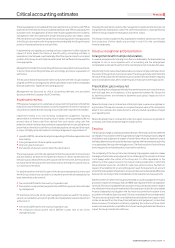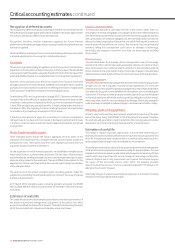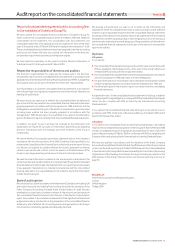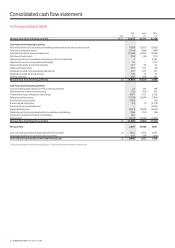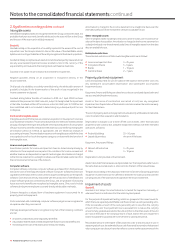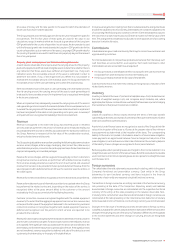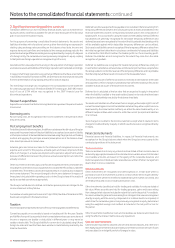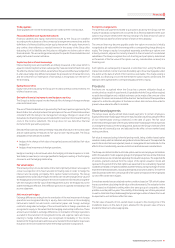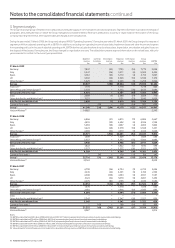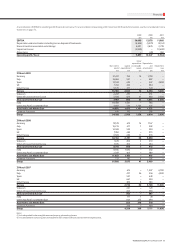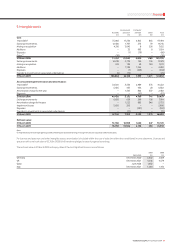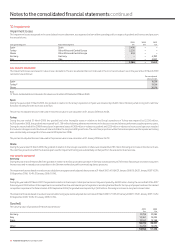Vodafone 2009 Annual Report Download - page 83
Download and view the complete annual report
Please find page 83 of the 2009 Vodafone annual report below. You can navigate through the pages in the report by either clicking on the pages listed below, or by using the keyword search tool below to find specific information within the annual report.
Financials
Vodafone Group Plc Annual Report 2009 81
Put option arrangements
The potential cash payments related to put options issued by the Group over the
equity of subsidiary companies are accounted for as financial liabilities when such
options may only be settled other than by exchange of a fixed amount of cash or
another financial asset for a fixed number of shares in the subsidiary.
The amount that may become payable under the option on exercise is initially
recognised at fair value within borrowings with a corresponding charge directly to
equity. The charge to equity is recognised separately as written put options over
minority interests, adjacent to minority interests in the net assets of consolidated
subsidiaries. The Group recognises the cost of writing such put options, determined
as the excess of the fair value of the option over any consideration received, as a
financing cost.
Such options are subsequently measured at amortised cost, using the effective
interest rate method, in order to accrete the liability up to the amount payable under
the option at the date at which it first becomes exercisable. The charge arising is
recorded as a financing cost. In the event that the option expires unexercised, the
liability is derecognised with a corresponding adjustment to equity.
Provisions
Provisions are recognised when the Group has a present obligation (legal or
constructive) as a result of a past event, it is probable that the Group will be required
to settle that obligation and a reliable estimate can be made of the amount of the
obligation. Provisions are measured at the directors’ best estimate of the expenditure
required to settle the obligation at the balance sheet date and are discounted to
present value where the effect is material.
Share-based payments
The Group issues equity-settled share-based payments to certain employees.
Equity-settled share-based payments are measured at fair value (excluding the effect
of non market-based vesting conditions) at the date of grant. The fair value
determined at the grant date of the equity-settled share-based payments is expensed
on a straight-line basis over the vesting period, based on the Group’s estimate of the
shares that will eventually vest and adjusted for the effect of non market-based
vesting conditions.
Fair value is measured using a binomial pricing model, being a lattice-based option
valuation model, which is calibrated using a Black-Scholes framework. The expected life
used in the model has been adjusted, based on management’s best estimate, for the
effects of non-transferability, exercise restrictions and behavioural considerations.
The Group uses historical data to estimate option exercise and employee termination
within the valuation model; separate groups of employees that have similar historical
exercise behaviour are considered separately for valuation purposes. The expected life
of options granted is derived from the output of the option valuation model and
represents the period of time that options are expected to be outstanding. Expected
volatilities are based on implied volatilities as determined by a simple average of no less
than three international banks, excluding the highest and lowest numbers. The risk-free
rates for periods within the contractual life of the option are based on the UK gilt yield
curve in effect at the time of grant.
Some share awards have an attached market condition, based on TSR, which is taken
into account when calculating the fair value of the share awards. The valuation for the
TSR is based on Vodafone’s ranking within the same group of companies, where
possible, over the past five years. The volatility of the ranking over a three year period
is used to determine the probable weighted percentage number of shares that could
be expected to vest and hence affect fair value.
The fair value of awards of non-vested shares is equal to the closing price of the
Vodafone’s shares on the date of grant, adjusted for the present value of future
dividend entitlements where appropriate.
Trade payables
Trade payables are not interest bearing and are stated at their nominal value.
Financial liabilities and equity instruments
Financial liabilities and equity instruments issued by the Group are classified
according to the substance of the contractual arrangements entered into and the
definitions of a financial liability and an equity instrument. An equity instrument is
any contract that evidences a residual interest in the assets of the Group after
deducting all of its liabilities and includes no obligation to deliver cash or other
financial assets. The accounting policies adopted for specific financial liabilities and
equity instruments are set out below.
Capital market and bank borrowings
Interest bearing loans and overdrafts are initially measured at fair value (which is
equal to cost at inception), and are subsequently measured at amortised cost, using
the effective interest rate method, except where they are identified as a hedged item
in a fair value hedge. Any difference between the proceeds net of transaction costs
and the settlement or redemption of borrowings is recognised over the term of
the borrowing.
Equity instruments
Equity instruments issued by the Group are recorded at the proceeds received, net
of direct issuance costs.
Derivative financial instruments and hedge accounting
The Group’s activities expose it to the financial risks of changes in foreign exchange
rates and interest rates.
The use of financial derivatives is governed by the Group’s policies approved by the
Board of directors, which provide written principles on the use of financial derivatives
consistent with the Group’s risk management strategy. Changes in values of all
derivatives of a financing nature are included within investment income and financing
costs in the income statement. The Group does not use derivative financial
instruments for speculative purposes.
Derivative financial instruments are initially measured at fair value on the contract date
and are subsequently remeasured to fair value at each reporting date. The Group
designates certain derivatives as either:
hedges of the change of fair value of recognised assets and liabilities (‘fair value •
hedges’); or
hedges of net investments in foreign operations.•
Hedge accounting is discontinued when the hedging instrument expires or is sold,
terminated, or exercised, or no longer qualifies for hedge accounting, or the Company
chooses to end the hedging relationship.
Fair value hedges
The Group’s policy is to use derivative instruments (primarily interest rate swaps) to
convert a proportion of its fixed rate debt to floating rates in order to hedge the
interest rate risk arising, principally, from capital market borrowings. The Group
designates these as fair value hedges of interest rate risk with changes in fair value of
the hedging instrument recognised in the income statement for the period together
with the changes in the fair value of the hedged item due to the hedged risk, to the
extent the hedge is effective. The ineffective portion is recognised immediately in the
income statement.
Net investment hedges
Exchange differences arising from the translation of the net investment in foreign
operations are recognised directly in equity. Gains and losses on those hedging
instruments (which include bonds, commercial paper and foreign exchange
contracts) designated as hedges of the net investments in foreign operations are
recognised in equity to the extent that the hedging relationship is effective. These
amounts are included in exchange differences on translation of foreign operations
as stated in the statement of recognised income and expense. Gains and losses
relating to hedge ineffectiveness are recognised immediately in the income
statement for the period. Gains and losses accumulated in the translation reserve are
included in the income statement when the foreign operation is disposed of.


